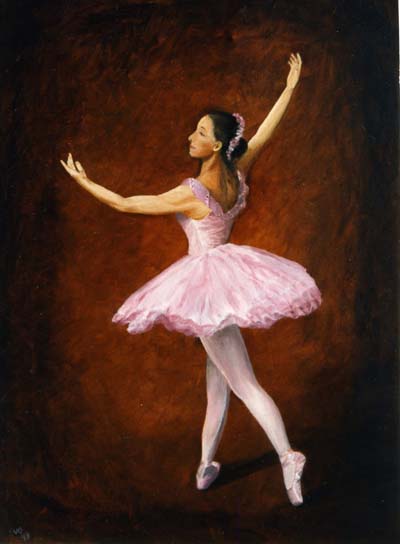|
By Sheila Orysiek
 SAN DIEGO—Anyone who knows me, even superficially, soon realizes that ballet has been a large part of my life. Therefore, it is not unusual for people to engage me in conversation about the ballet; how much they enjoy it or how little they know - or want to know - about it. I understand either position. Not everyone has to like the same thing - the world would be rather boring if we all had the same interests (probably wouldn’t work out very well either). SAN DIEGO—Anyone who knows me, even superficially, soon realizes that ballet has been a large part of my life. Therefore, it is not unusual for people to engage me in conversation about the ballet; how much they enjoy it or how little they know - or want to know - about it. I understand either position. Not everyone has to like the same thing - the world would be rather boring if we all had the same interests (probably wouldn’t work out very well either).
Some people are religious, some are not. Some like opera, some don’t. Just as there are several layers to understanding the Torah, there are various levels to understanding most everything else, including ballet. One doesn’t have to delve through all four layers to derive pleasure or satisfaction. I might enjoy a wonderful supper without wanting to know how the chef created it. I attend Torah study with a minimal of knowledge and yet derive a maximum of pleasure.
I do, however, take issue when someone says - either defensively or dismissively - “I don’t go to ballet because I don’t understand it.” Usually I shrug my shoulders and say to myself “so be it.” But, every once in a while when in a (rare) cantankerous mood I’ll respond with “what’s to understand? You just go, people dance, you watch and then either applaud and leave or leave without applauding.”
If the respondent is still around, I mention that we usually don’t check to see if we understand a movie before we go. Or a symphony, or pop music, or a gymnastics competition, et al. Performing arts theaters almost always provide program notes for drama, opera, concerts - and - oh yes - ballet! So, as long as one is literate - one can read those program notes.
Yes, of course, there are fine points to ballet; technical, historical, artistic. But this is true of almost every endeavor including sports, art exhibitions, stock market, railroading, sailing, hunting, teaching - add your own to the list. One doesn’t have to know the fine points to enjoy a basketball game - one can just enjoy the idea of a ball being thrown so accurately that it goes into a hoop.
Another hesitation I hear is - “all those men in tights.” Well, dear friend, tights were originally created for men - a la the Three Musketeers. Men were very proud of their legs (no that isn’t a typo) and wanted to show them off. Coming to court and “making a leg” - a reverence (bow) to the other nobles was an exceedingly important social protocol. Tights showed off legs. Tights also showed off wealth - only the well heeled (pun intended) could afford a pair of silk tights walked all the way on the Silk Road from China.
As for present day squeamishness - men in those teeny tiny Olympic swimming thingies are surely more revealing than tights. This same squeamishness, of course, doesn’t apply to observing women in various stages of undress; the drum major is fully clothed, the majorette usually has bare legs.
Then, I’m told that men wearing pointe shoes are - well - unmanly. Uh - except for very rare roles in which men portray a character like Bottom (a donkey) in Midsummer Night’s Dream - men don’t wear pointe shoes. And in that role the man is stamping his feet much as a donkey might; he is not tripping lightly through the tulips.
Someone told me she wouldn’t go to the ballet because she knew the dancers all speak French and she didn’t understand French. She didn’t believe me when I told her that she wouldn’t hear any French because dancers in classical ballet don’t speak. She then asked what do they do? Dance, they just dance. French is the technical language of the ballet, but it is not spoken in performance; only in the classroom as names of the various steps and exercises.
“How do I know I will like it?” is the next challenge I hear. Well, there are no guarantees. Same for football, soccer, horse racing, a movie and anything else one cares to name. You don’t know unless you try it.
Another misconception: “Everyone (the audience) will be rich/old/elite.” The audience for the ballet runs both the economic and age gamut. Seats for matinees, in the balcony, on week nights, or bought the same day, are very affordable. It’s a less expensive outing than a football game. And no one is going to give test to see how elite you are.
“I won’t like the music.” That’s entirely possible, but some of the most familiar music - like Tchaikovsky’s Nutcracker, Sleeping Beauty and Swan Lake, was written specifically for the ballet. Stravinsky and many other famous composers were happy to write for the ballet. Some one once told me he was disappointed the dancers didn’t sing. Well, some singers don’t dance. If you want both then I suggest musical theater.
Go to the top of right column
|
|

And, of course, there’s the usual litany of disparaging remarks about male dancers. This is a western prejudice, not a worldwide one. In almost every form of dance - Russian,
Spanish, folk, Irish, Japanese, Indian, American Indian, Pacific Islands, African, etc., - the male dancer predominates. It is not unusual for women to be excluded entirely or very much on the periphery. The male ballet dancer is an athlete in every sense of the word and he does it without grunting, grimacing and spitting.
“All those ballets are so old,” is another canard I hear. Surely, not all - some - not even most - are old. Most of the repertoire is neo-classical, with a lot of modern dance influence. More and more modern dance choreographers are creating for the ballet companies. The old classics are still danced because people still love them. That should say something, shouldn’t it?
“Maybe I’d go - but only if Russians are dancing, they are the only good ballet dancers.” Russians are spectacular dancers! But, the dance capital of the world is New York City, USA. It’s been this way for decades. When the super-star dancers Rudolph Nureyev, Natalia Makarova and Mikhail Baryshnikov defected from the Russian companies - they defected to the West. No one has left to go East. The Paris Opera Ballet, the Royal Ballet (Covent Garden, London), American Ballet Theatre, New York City Ballet, San Francisco Ballet - are not second best, but share first rank with the Bolshoi (Moscow) and the Mariinsky-Kirov Ballet (St. Petersburg).
At this time, some of the most exciting dancers are coming from Hispanic countries: South America, Cuba and Spain. They are bringing a whole new level of excitement to the ballet.
“Ok, ok - I’ll try it. But I was told they walk like ducks.” This is true - but only on the street - not on the stage. On the stage they dance like angels.
Maybe this will help:
Like a Duck to Ballet
For years I studied ballet
And now with some luck
I dance like a swan
And walk like a duck
My teacher said
This is fifth position
Heel to toe
Held in opposition
But when I try
I can’t seem to win
My heels turn out
My toes turn in
The teacher frowns
I should’ve stayed in bed
Spotted my feet
And pointed my head
But I am not sad
'Cause whatever I lack
I make up in
The way I quack.
|
|

